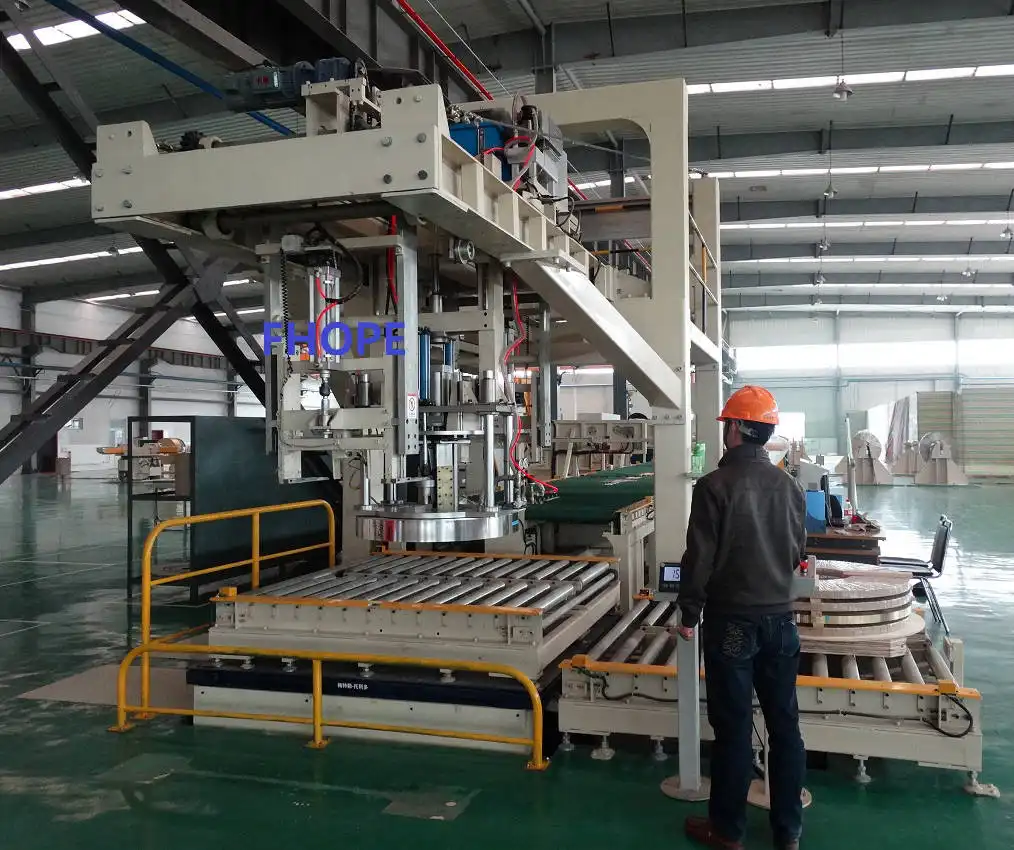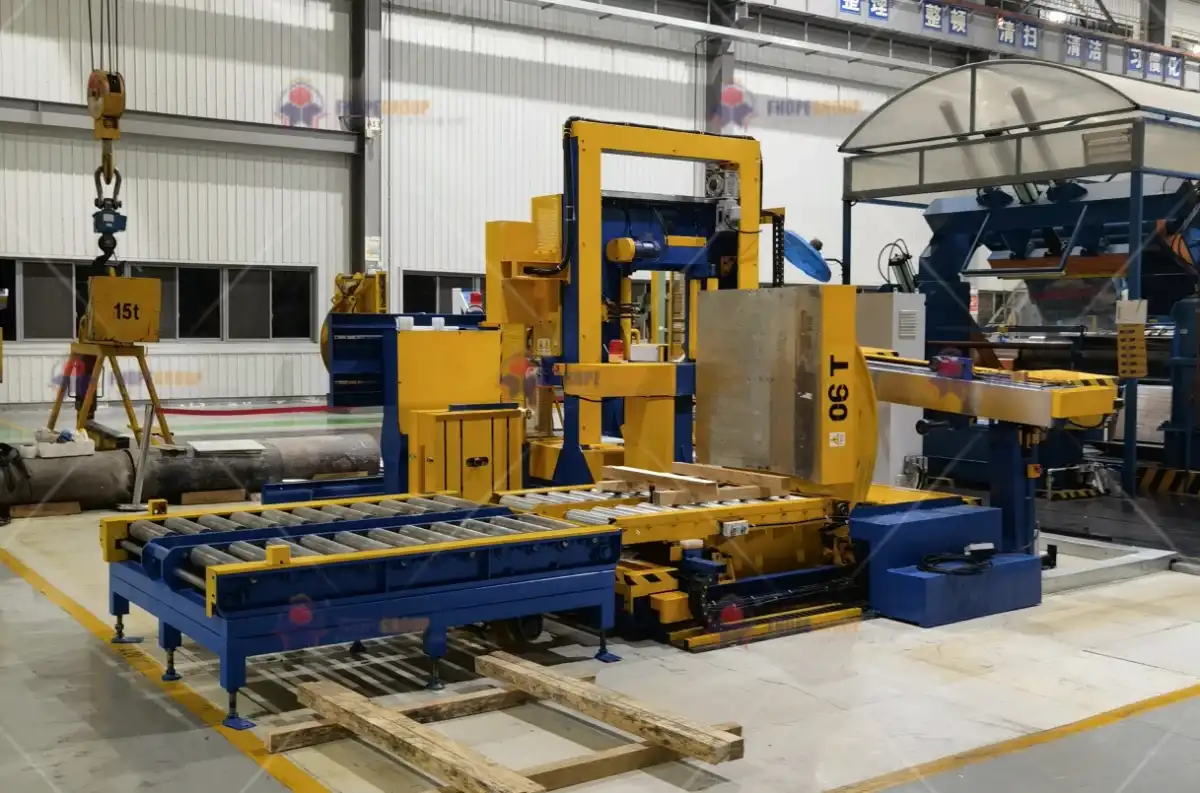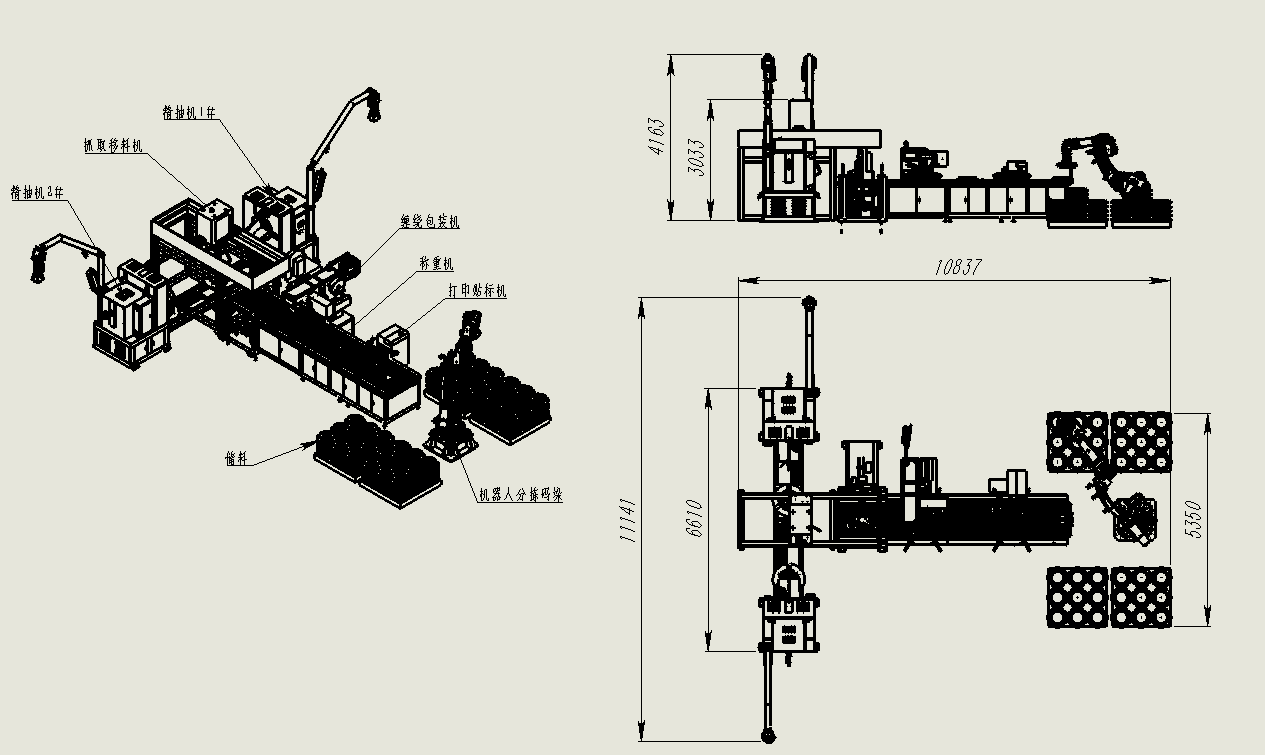Your steel mill runs like a finely tuned machine. You pour immense effort into perfecting every stage of production, from the furnace to the rolling mill. The result is high-quality Italian steel, a product respected worldwide. But what happens after the coil is made? It faces a long journey, exposed to moisture, salt, and rough handling. A single spot of rust or a dent from shipping can turn a perfect coil into a rejected shipment, damaging your profits and, more importantly, your hard-earned reputation. I've seen this happen. Aging, inefficient wrapping equipment often becomes the weakest link in an otherwise strong production chain, silently eroding your bottom line.
Choosing the best coil wrapping system for Italian steel manufacturers requires a detailed analysis of your specific coil types, production volume, level of automation needed, and integration with existing systems. You must also consider long-term maintenance costs. The ideal system balances the initial investment with operational efficiency and total product protection to maximize your return on investment (ROI). It's not just a machine; it's a critical part of your quality promise.

I have walked in your shoes, first as an engineer on the factory floor and later as the founder of my own packing machine factory. This journey taught me that every piece of equipment is a strategic decision. The right choice can unlock growth, while the wrong one can become a persistent headache. I want to share the practical knowledge I've gained to help you navigate this decision. Let's break down the key factors to ensure your new coil wrapping system is a powerful asset for years to come.
What Key Factors Should Italian Steel Producers Consider for Coil Protection?
You've mastered the complex metallurgy to create superior steel. But is your packaging strategy undermining that excellence? When a coil leaves your mill, its value is at risk. Poor wrapping can lead to corrosion from humidity or physical damage during transit. For Italian producers who pride themselves on quality and often export by sea, this is a major concern. A single container's journey can expose your product to corrosive salt air, turning a pristine coil into a customer complaint. The solution is not just to wrap the coil, but to create a protective shield engineered for its journey.
Italian steel producers must prioritize three key factors for coil protection. First, select the right wrapping material, such as VCI paper or high-performance stretch film. Second, define the optimal wrapping method, whether that's eye-to-sky or eye-to-wall. Third, ensure the packaging creates a complete, sealed barrier against moisture, salt, and physical impacts.

Let's dive deeper into these elements. This is where the engineering meets the real world of logistics and customer satisfaction. Making the right choices here is fundamental to protecting your product and your brand.
Breaking Down Coil Protection
Protecting a steel coil is about creating a micro-environment around it. This environment needs to defend against chemical, physical, and atmospheric threats. As an engineer, I like to break problems down into their core components.
H3: Choosing the Right Wrapping Material
The material you choose is your first line of defense. It’s not a one-size-fits-all decision. The choice depends on the type of steel, the duration of storage, and the shipping conditions.
| Material Type | Primary Use | Protection Level | Cost Factor | Environmental Note |
|---|---|---|---|---|
| VCI Paper/Film | Long-term storage, sea freight | Excellent (Anti-Corrosion) | High | Paper is often recyclable; films vary |
| Stretch Film | Dust and moisture protection | Good (Physical & Moisture) | Medium | Often recyclable LDPE, but requires clean stream |
| Woven Fabric | Heavy-duty physical protection | Excellent (Tear Resistance) | High | Can be reusable, but often plastic-based |
| Crepe Paper | Basic interleaving, scratch protection | Fair (Basic Physical) | Low | Highly recyclable and biodegradable |
I remember a client in the automotive sector who was shipping high-finish steel coils. They used standard stretch film and faced a 5% rejection rate due to "edge rust" from condensation during sea freight. We analyzed their process and recommended a switch to a VCI-impregnated stretch film. The material cost was about 15% higher. But the rejection rate dropped to zero. The savings from eliminating rework, scrap, and freight for returned goods paid for the material difference many times over. This is a clear example of how a small change in material can have a massive impact on the bottom line. For Italian steel, known for its finish and quality, this level of protection is not a luxury; it is a necessity.
H3: Defining the Wrapping Method
How you apply the material is just as important as the material itself. The two primary methods are determined by the coil's orientation.
-
Eye-to-Wall (Horizontal Axis): The coil sits on its side, and the wrapping material passes through the "eye" or center hole. This is the most common method for steel coils. It provides excellent coverage and stability, making it ideal for automated lines where coils are moved by conveyors.
-
Eye-to-Sky (Vertical Axis): The coil sits flat on its base. The wrapping machine orbits the coil. This is often used for very large or unstable coils, or in facilities where coils are handled primarily by C-hooks on overhead cranes.
The choice impacts your entire end-of-line logistics. An eye-to-wall system integrates smoothly with roller conveyors and tilters. An eye-to-sky system might require more floor space but can simplify handling if you are loading directly onto trucks or rail cars with a crane. We must analyze your current and future material flow to select the machine that fits your operation, not the other way around.
How Does Automation Level Impact ROI in Coil Wrapping?
You see the sleek, fully-automated packaging lines in industry videos, and they look impressive. But the investment is significant. You ask yourself, "Is it truly worth it?" On the other hand, you feel the daily pressure of rising labor costs, the difficulty in finding skilled workers, and the inconsistencies that come with manual processes. Sticking with an old semi-automatic system can create a bottleneck in your production, limiting your throughput and hurting your ability to meet fluctuating market demands. The decision feels like a difficult balance between a large capital expense and ongoing operational inefficiency.
The level of automation in a coil wrapping system directly impacts your ROI by reducing labor costs, increasing throughput, and improving wrapping consistency which lowers material waste. Fully automated systems offer the highest long-term returns for high-volume producers by operating 24/7 with minimal human intervention. Semi-automatic systems provide a more balanced, lower-cost entry point for mills with smaller or more varied production schedules, still offering significant improvements over manual wrapping.

To make the right choice, you need to move beyond gut feeling and look at the numbers. A proper ROI analysis isn't just an accounting exercise; it's a strategic tool. It helps you see the future costs and benefits of your decision. Let's explore how to calculate this and what "hidden" factors to consider.
Calculating the True Return on Automation
As a factory owner, I live by the numbers. Every investment must be justified. A CEO like Javier Morales would demand a thorough feasibility analysis, and that's the right approach. Let's break down how to evaluate the automation decision.
H3: Manual vs. Semi-Automatic vs. Fully Automatic
First, we need to understand the practical differences. It's not just about speed; it's about labor, consistency, and process integration.
| Feature | Manual Wrapping | Semi-Automatic System | Fully Automatic System |
|---|---|---|---|
| Initial Cost | Very Low | Medium | High |
| Labor Requirement | 2-3 Operators/Shift | 1 Operator | 0-1 Supervisor for multiple lines |
| Throughput | 5-10 Coils/Hour | 15-30 Coils/Hour | 30-60+ Coils/Hour |
| Consistency | Low (Operator dependent) | High | Very High (Machine controlled) |
| Material Waste | High (Inconsistent overlap) | Low | Very Low (Optimized recipes) |
| Safety Risk | High (Manual handling) | Medium | Low (Guarded operation) |
| Best For | Very low volume, custom jobs | Medium volume, varied products | High volume, standardized production |
H3: A Practical ROI Calculation
Let's do a simple calculation. I once worked with a steel service center in Europe. They were running two shifts with two people per shift manually wrapping slit coils.
- Labor Cost: 4 operators x 40,000 EUR/year = 160,000 EUR/year.
- Material Waste: They estimated about 10% excess film usage due to inconsistent application. This cost them an extra 20,000 EUR/year.
- Total Annual Cost: 180,000 EUR.
They were considering a fully automatic line that cost 350,000 EUR. This line would require only one supervisor to oversee it and two other machines. We allocated 1/3 of that person's salary to the wrapping line, so the new labor cost was roughly 15,000 EUR/year. The machine's precision would cut material waste to almost zero, saving the full 20,000 EUR.
- Annual Savings: (Old Cost 180,000) - (New Cost 15,000) = 165,000 EUR/year.
- Simple Payback Period: (Investment 350,000) / (Annual Savings 165,000) = 2.12 years.
For a machine with a 15-20 year lifespan, a payback period of just over two years is an excellent investment. This calculation didn't even include the value of increased throughput or improved safety. When the CEO saw this breakdown, the decision was simple. This is the kind of analysis that turns a "cost" into a strategic "investment."
What are the Long-Term Maintenance and Support Considerations?
You’ve found a machine with the perfect specs and a great price. The purchase is made, and it runs well for the first year. Then, a critical sensor fails. You call the supplier. They tell you the part has a six-week lead time from their overseas factory. Your entire finishing line comes to a halt. Every hour of downtime costs you thousands in lost production and risks delaying critical customer orders. This is a nightmare scenario I have seen play out too many times. An attractive initial price can quickly become a very expensive problem if the long-term support is not there.
Long-term maintenance and support considerations involve evaluating the supplier's spare parts availability, the responsiveness of their technical support, and the quality of their preventative maintenance programs. The most important factor is choosing a supplier who acts as a strategic partner, not just a vendor. A partner with a strong local or regional service presence and a clear commitment to your uptime is critical for minimizing downtime and maximizing the life of your equipment.

This is one of the most overlooked aspects of purchasing industrial machinery. The machine itself is just the beginning. The real value is in the reliability and the support that stands behind it for the next 15-20 years. Let's dive deeper into what you should be looking for in a true equipment partner.
Building a Partnership for Uptime
When I founded SHJLPACK, I built it on the principle of being a total solution provider. This philosophy came directly from my experience as an engineer seeing the frustration caused by unresponsive suppliers. Your goal of 95% equipment uptime is only achievable with a robust maintenance strategy and a supplier who shares that goal.
H3: The Supplier as a Strategic Partner
A vendor sells you a machine. A partner helps you solve a problem. How can you tell the difference?
- A vendor's job ends at delivery. Their success is measured by the sale.
- A partner's job starts at installation. Their success is measured by your machine's performance over its entire lifecycle.
When you are vetting suppliers, ask them about their support philosophy. Ask for references from customers who have owned the equipment for 5+ years. Their answers will tell you everything you need to know. Do they talk about service contracts, training programs, and remote diagnostics? Or do they just talk about the machine's features? At SHJLPACK, our slogan is "TOTAL SOLUTION FOR WRAPPING MACHINE" because we understand that the machine is just one part of the equation. The solution includes the training, service, and support that ensure it runs efficiently for decades.
H3: A Practical Maintenance Support Checklist
When evaluating a potential supplier, use this checklist to score their support capabilities.
| Support Feature | What to Look For | Why It Matters |
|---|---|---|
| Spare Parts | A list of critical spares; local or regional stock. | Reduces downtime from weeks to hours for common failures. |
| Technical Support | 24/7 availability; remote diagnostic capabilities. | Immediate troubleshooting can solve many issues without a site visit. |
| Documentation | Clear, detailed manuals (electrical, mechanical) in your language. | Empowers your own team to perform first-level maintenance. |
| Training Programs | On-site training for operators and maintenance staff. | Proper operation and care prevent many common problems. |
| Preventative Maintenance | Structured programs and service contracts offered. | Proactively replaces wear parts before they fail, preventing unplanned stops. |
H3: The True Cost of Downtime
To understand the value of good support, you must understand the cost of its absence. Let's say your line packages 30 coils per hour, and each coil represents 500 EUR in profit. One hour of unplanned downtime costs you 15,000 EUR in lost profit, not to mention the potential penalties for late shipments. If a strong preventative maintenance program, costing 5,000 EUR a year, prevents just one hour of downtime, it has already paid for itself three times over. This is the logic that drives world-class manufacturing operations.
How Can a Wrapping System Integrate with Digital Factory Goals?
You are investing heavily in your digital transformation. You're implementing a Manufacturing Execution System (MES) to get a real-time view of production, using IoT sensors to monitor equipment health, and leveraging data to make smarter decisions. But often, the packaging area remains an "information island," disconnected from this digital ecosystem. This disconnect creates a critical blind spot. You can't automatically track your finished product, you can't measure the Overall Equipment Effectiveness (OEE) of your final process step, and you can't link quality data from the mill directly to the final packaged coil.
A modern coil wrapping system can integrate with your digital factory goals by connecting directly to your plant's MES or ERP system. This is no longer a futuristic concept; it's a practical necessity. This integration allows for the seamless, two-way exchange of data. It enables real-time production tracking, automated quality control, and the collection of valuable data for analysis and process improvement, turning your wrapper from an isolated machine into an intelligent, connected asset.

This is a topic I am very passionate about because it's where the future of manufacturing lies. I've helped many clients bridge this gap. Integrating your wrapping line is the final piece of the puzzle for achieving total production visibility and control.
Making Your Wrapping Line a Smart Asset
A CEO like Javier, who has already implemented smart platforms, understands that data is the key to unlocking the next level of efficiency. Your packaging machine should be a source of rich data, not a black box.
H3: From Isolated Machine to Connected Node
How does a machine connect to a factory-wide system? The key is communication protocols. Modern PLCs (Programmable Logic Controllers) on wrapping machines are equipped with industrial networking capabilities like Ethernet/IP or Profinet. They can speak the same language as your central MES.
Here's how it works in practice:
- MES to Machine: When a coil arrives at the wrapping station, its unique ID is scanned. The MES sends a signal to the wrapping machine's PLC: "This is Coil #XYZ123. It is galvanized steel for an automotive customer. Use Wrapping Recipe #4 (VCI film, 75% overlap, extra edge protection)."
- Machine to MES: The machine automatically configures itself and performs the wrapping cycle. Once complete, it sends data back to the MES: "Coil #XYZ123 complete. Cycle time: 95 seconds. Film consumed: 2.8 kg. No faults occurred. Operator: Machine_Auto."
This closed-loop communication eliminates human error in selecting wrapping parameters and creates a perfect digital record for every single coil.
H3: The Data That Drives Improvement
What data should your wrapping system provide? This data is the fuel for achieving your strategic goals, like reducing costs and improving utilization.
| Data Point | How It Helps | Javier's Goal It Supports |
|---|---|---|
| Coil ID / Recipe Used | Creates a digital "birth certificate" for quality traceability. | Improve Product Quality |
| Cycle Time | Measures true throughput and helps calculate OEE. | Increase Capacity Utilization |
| Material Consumption | Tracks film/paper usage for precise cost control per coil. | Reduce Operational Costs by 8% |
| Alarm/Fault History | Identifies recurring problems for root cause analysis. | Boost Equipment Uptime to 95% |
| Motor Current/Vibration | (With extra sensors) Feeds data for predictive maintenance models. | Advance Digital Transformation |
H3: The Future is Predictive
This leads us to the most advanced stage: predictive maintenance. This is a primary goal for any forward-thinking factory owner. By placing sensors on critical components of the wrapping machine—like the main ring drive motor or the film stretch rollers—we can monitor their health in real time. We can analyze this data to detect tiny changes in vibration or power draw that signal a future failure. Instead of waiting for a breakdown, the system can generate a work order: "The bearing on the main drive motor shows a 15% increase in vibration. Recommend replacement during the next scheduled maintenance window." This transforms your maintenance from a reactive fire-fight to a proactive, planned activity, which is the key to hitting that 95% uptime target.
Conclusion
Choosing the right coil wrapper is a strategic investment in your quality, efficiency, and future. Focus on protection, ROI, and partnership to secure your success in the competitive Italian market.




